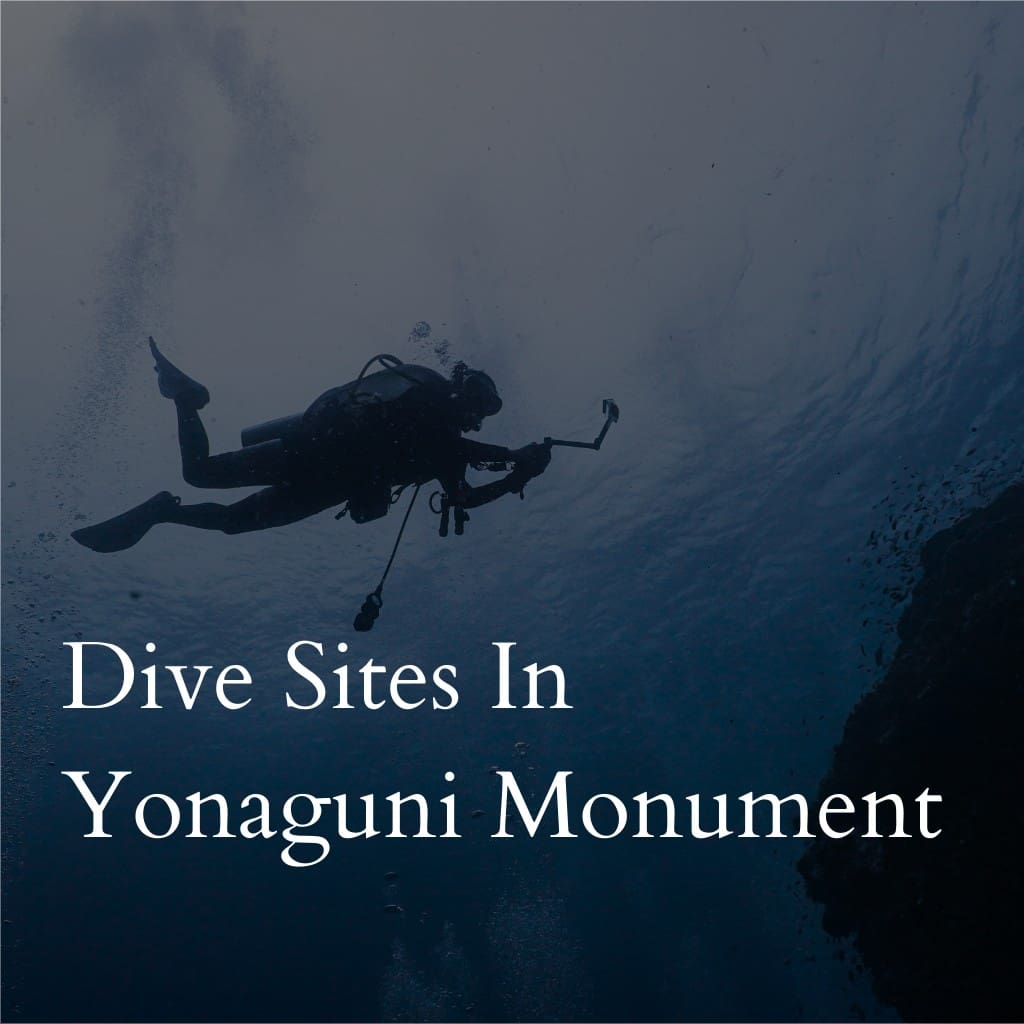What truly makes the Yonaguni Monument special is not just its mysterious origins, but also its dramatic underwater landscape and the rich marine life that adorns it. Divers exploring this site can expect to be awed by its grand scale, intricate features, and the sheer sense of history it embodies.
In this article, we’ll dive deep into the wonders of Yonaguni Monument, touching upon:
- An exploration of the monument’s main features and geological peculiarities.
- The diverse marine species that inhabit the area around the structure.
- Unique encounters with both the monument and its aquatic residents.
- Tips for capturing the perfect underwater photographs at this site.
- Suitability and considerations for divers of different experience levels.
- Essential practical information, including water conditions, visibility, and safety guidelines.
Top Dive Sites
The Main Monument
Description: The Main Monument is the heart of the Yonaguni site, featuring a sprawling series of flat terraces, steps, and massive angular blocks. This impressive structure measures approximately 150 meters long and 40 meters wide, descending gradually from a shallow depth of about 5 meters to deeper sections reaching 25 meters. The monumental scale and detailed rock formations often lead divers to question whether it is a man-made or natural wonder.
Marine Species: The Main Monument is teeming with marine life, including schools of fusiliers, yellowtail snappers, and butterflyfish that dart around the structures. Larger species such as barracudas and trevallies are frequently sighted patrolling the area. The crevices and overhangs also provide shelter for various crustaceans, moray eels, and even the elusive lionfish.
Unique Encounters: One of the most thrilling aspects of diving the Main Monument is encountering its resident hammerhead sharks, particularly from January to March. The site’s strong currents attract these magnificent creatures, offering divers a chance to witness them glide majestically around the structure.
Photography: The dramatic contrast between the geometric formations of the monument and the organic movement of the marine life provides endless photographic opportunities. Use wide-angle lenses to capture the grand scale of the monument, and macro settings for the smaller, intricate marine species hiding in nooks and crannies.
Suitability: Due to the site’s depth and strong currents, the Main Monument is recommended for advanced divers with experience in drift diving. Strong navigation skills are also crucial to maneuver safely around the expansive underwater structure.
Gallery
Description: The Gallery is another intriguing part of the Yonaguni Monument, characterized by a series of parallel, horizontal lines etched into the rock face, resembling a corridor. This section, found at a depth of around 15 to 20 meters, enhances the debate on whether these formations are natural or man-made. The clean, straight lines and flat surfaces invoke the image of ancient architectural design.
Marine Species: The Gallery is home to numerous reef-dwelling species such as triggerfish, parrotfish, and angelfish. Invertebrates like octopuses and various species of nudibranchs also make their home in the crevices, adding to the biodiversity.
Unique Encounters: Divers exploring the Gallery often encounter hawksbill and green sea turtles, which can be seen grazing on the algae-covered surfaces of the monument. The occasional sighting of marbled rays adds to the site’s allure.
Photography: The combination of light dynamics created by the lines and shadows in the Gallery, along with its resident marine life, offers excellent photography prospects. Consider using both macro and wide-angle lenses to capture the intricate details as well as the expansive views.
Suitability: The Gallery is suitable for intermediate to advanced divers. While the currents are usually less intense than at the Main Monument, they still require a degree of experience and confidence in underwater navigation.
Triangle Pool
Description: Triangle Pool is a unique part of the Yonaguni Monument, named for its triangular-shaped depression that fills with seawater. Found at a depth of around 18 meters, this area is marked by sharp angles and smooth walls, resembling the basin of an ancient pool. The calm waters within this section provide a tranquil contrast to the open ocean outside.
Marine Species: The waters of Triangle Pool attract a variety of fish, including groupers, sweetlips, and damselfish. The nooks and crannies of the triangular basin are often visited by cleaner shrimp and gobies, making it a delightful spot for observing symbiotic relationships in marine life.
Unique Encounters: The sheltered nature of Triangle Pool offers unique encounters with juvenile fish and invertebrates seeking refuge from the stronger currents outside. Divers may also spot the elusive banded sea krait weaving through the crevices.
Photography: The clear, still waters of Triangle Pool provide ideal conditions for underwater photography, especially for close-up shots and macro photography. The striking geometry of the triangular basin can create visually appealing compositions, enhanced by the ambient lighting that penetrates the water.
Suitability: Triangle Pool can be navigated by intermediate divers, but advanced divers will benefit most from the unique structure and the skills required to explore the nuances of the site thoroughly.
Considerations for Each Dive Site
Water Temperature: The water temperature around the Yonaguni Monument ranges between 24°C (75°F) in winter and 29°C (84°F) during the summer months. A 3mm to 5mm wetsuit is generally recommended for comfort and thermal protection, depending on your cold tolerance and the time of year. The warm waters make it suitable for extended dive sessions without significant thermal discomfort.
Visibility: Visibility at the Yonaguni Monument is typically excellent, often exceeding 30 meters (100 feet), especially during the winter months. This high visibility allows divers to fully appreciate the architectural features of the monument and spot marine life from a distance. However, visibility can occasionally be affected by strong currents or seasonal fluctuations, so it’s wise to check local conditions before diving.
Currents and Tides: Currents around Yonaguni can be strong and unpredictable, particularly at the Main Monument and Gallery sites. These currents are caused by the Kuroshio Current, which flows northward past the island. Divers must be prepared for drift diving conditions and should be experienced in managing strong underwater currents. Tidal changes can also influence the dive conditions, so timing your dive relative to tide schedules is crucial for optimal safety.
Safety Tips:
- Dive Planning: Meticulously plan your dive, including depth limits, dive duration, and emergency procedures. Discuss the plan thoroughly with your dive buddy.
- Equipment Check: Ensure that all diving equipment is in top condition, particularly your buoyancy control device and regulators. Carrying a dive computer is highly recommended to manage depths and time accurately.
- Navigation Skills: Strong navigation skills are essential due to the monument’s complex layout and strong currents. Always carry a compass and use natural markers on the monument to maintain orientation.
- Progressive Training: Before diving the main sites, ensure you have progressive training and experience in advanced diving techniques, especially drift diving and deep diving.
- Communication: Maintain continuous communication with your dive buddy, using clear hand signals. In turbulent conditions, staying close to your buddy is critical for safety.
- Surface Marker Buoys: Always carry and deploy a surface marker buoy (SMB) to signal your position to boat operators, especially in areas with strong currents.
Regulations: Adhering to local regulations and conservation guidelines is vital to protect the marine environment and ensure the safety of all divers:
- Permits and Local Guidance: Ensure you have the necessary permits for diving in Yonaguni waters and always dive with a reputable local guide or dive operator well-versed in the area’s conditions.
- No Touching or Collecting: Avoid touching the rock formations of the monument or disturbing the marine life. Do not collect souvenirs or marine specimens to preserve the site’s natural and historical integrity.
- Reef-Safe Products: Use reef-safe sunscreen and personal care products to minimize environmental impact on the underwater ecosystem.
- Proper Waste Management: Dispose of any waste responsibly and avoid throwing anything overboard. Keep the dive sites clean and free from pollution.
- Certification Levels: Dive only within the limits of your certification and skills. Sites like the Main Monument are suited for advanced divers due to the depth and currents, while sites like Triangle Pool may be manageable for intermediate divers.
- Environmentally Friendly Practices: Adhere to environmentally friendly diving practices, such as neutral buoyancy and awareness of your surroundings to prevent accidental damage to the site.
Wrap Up
Diving at the Yonaguni Monument offers a truly unique experience that blends the mystery of potential ancient civilizations with the thrill of exploring dramatic underwater landscapes. From the impressive Main Monument with its grand terraces and hammerhead visitors, to the intricate Gallery and serene Triangle Pool, each dive site presents a distinct adventure that captivates the imagination and senses.
The water’s warmth, excellent visibility, and rich marine biodiversity further enhance the diving experience, ensuring that both the geological wonders and the marine life leave lasting impressions. While the environmental conditions and strong currents make it more suited for experienced divers, the rewards of diving here are unparalleled.
Respect for local regulations and safe diving practices are paramount to preserving the site’s natural and historical significance. So, prepare your dive gear, brush up on your skills, and get ready to uncover the enigmatic secrets of Yonaguni Monument. Whether you’re navigating through the structured formations or encountering majestic marine creatures, Yonaguni promises an unforgettable underwater journey.


Leave a Reply